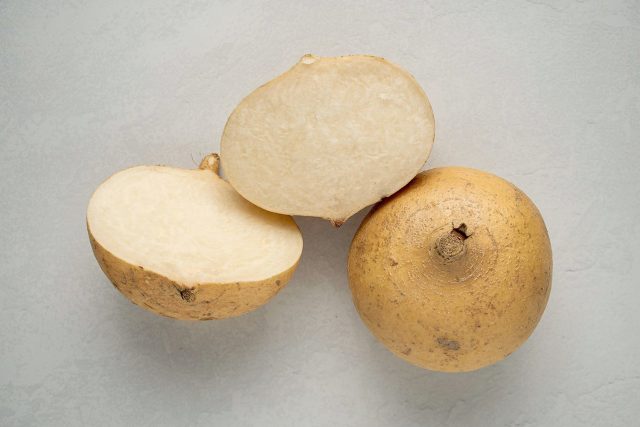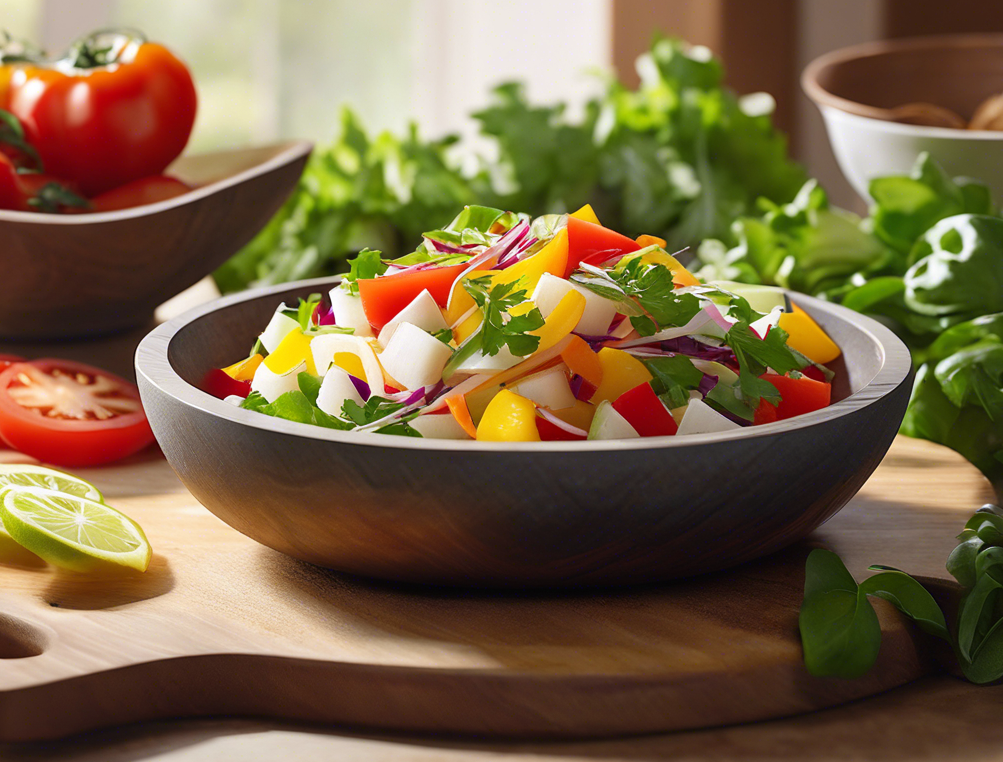Jicama

Jicama is a versatile and nutritious vegetable that can be enjoyed in many ways, offering numerous health benefits and a delightful crunch to various dishes!
Jicama also known as Mexican yam bean or Mexican turnip, is a root vegetable native to Mexico and Central America. It has a crisp texture and a mildly sweet, nutty flavor, often compared to that of a water chestnut or pear. it is typically eaten raw in salads, slaws, or as a crunchy snack, but it can also be cooked in various dishes.
Health Benefits of Jicama:
1. **Low in Calories**: Jicama is low in calories, making it an excellent choice for those looking to manage their weight.
2. **High in Fiber**: It contains a significant amount of dietary fiber, which aids digestion, promotes gut health, and helps keep you feeling full.
3. **Rich in Nutrients**: Jicama is a good source of vitamin C, vitamin B6, potassium, and antioxidants, which support overall health.
4. **Hydrating**: With a high water content (about 90%), jicama can help keep you hydrated.
5. **Blood Sugar Regulation**: The fiber and inulin (a type of prebiotic fiber) in jicama may help regulate blood sugar levels, making it beneficial for those with diabetes. You may also like
6. **Supports Immune Function**: The vitamin C content in jicama can boost the immune system and help the body fight off infections.
7. **Heart Health**: The potassium in it can help manage blood pressure, contributing to heart health.
Here are some additional details about jicama, including its culinary uses, nutritional profile, and interesting facts:
Culinary Uses:
Raw Dishes: It is often enjoyed raw in salads, salsas, and as a crunchy snack. It pairs well with lime juice, chili powder, and salt, making for a refreshing treat.
Cooking: While it is most commonly eaten raw, it can also be cooked. It can be stir-fried, roasted, or added to soups and stews. Cooking softens its texture slightly but retains its crunch.
Substitute: Jicama can serve as a low-carb alternative to potatoes in various recipes, like hash browns or fries.
Nutritional Profile (per 100g serving):
**Calories**: Approximately 38
**Carbohydrates**: 9g
**Fiber**: 4.9g
**Sugars**: 1.8g
**Protein**: 0.72g
**Fat**: 0.1g
**Vitamin C**: Around 20mg (about 22% of the recommended daily intake)
**Potassium**: About 419mg join our tech community and be part or the digital revolution!
Interesting Facts:
**Origin**: Jicama is originally from Mexico and has been cultivated for centuries. It is now grown in various parts of the world, including the United States, where it is often found in farmers’ markets.
**Varieties**: While the most common type of jicama is the white-fleshed variety, there are others, such as the purple-skinned jicama, which has a slightly different taste and texture.
**Storage**: Jicama should be stored in a cool, dry place, away from sunlight. It can last for several weeks if kept properly. Once cut, it should be refrigerated and consumed within a few days.
**Cultural Significance**: In Mexican cuisine, it is often used in street food, served with chili powder and lime, making it a popular snack during festivals and gatherings.
Health Considerations:
**Digestive Health**: The fiber content in jicama not only aids digestion but also promotes regular bowel movements and helps prevent constipation.
**Weight Management**: Because it’s low in calories and high in fiber, jicama can be a filling snack that helps curb hunger without adding too many calories to your diet.
In summary, the fruit is a versatile and nutritious vegetable that can be enjoyed in many ways, offering numerous health benefits and a delightful crunch to various dishes! Travel back in time and experience history like never before!
Incorporating jicama into your diet can be a tasty and nutritious way to enhance your meals and snacks!